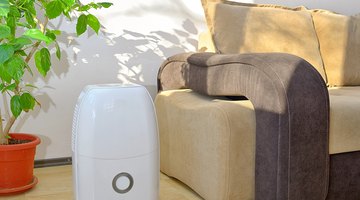Where Do You Place a Dehumidifier for the Best Results?
Table of Contents
A dehumidifier is supposed to make a room more comfortable by reducing the amount of moisture in the air to an ideal level. In the right place it can make air conditioning more effective and prevent mold damage.

If it's put in the wrong place, however, it can't function properly -- or even worse, it could become an electrical hazard.
Air Circulation
Since dehumidifiers continuously draw air in and then expel it during operation, most models should be placed away from anything that would block air flow, such as walls and furniture. Follow manufacturer's instructions, but a general rule of thumb is to keep the dehumidifier at least 6 inches away from walls and other objects that restrict circulation. Models with a top-mounted discharge are designed to be placed close to walls or solid surfaces without affecting the unit's operation.
Dust and Dirt
As the dehumidifier draws air into the internal chambers, it also pulls in anything that is in the air, like dirt or lint. Although most dehumidifiers contain a filter to catch these particles, it can become overwhelmed if the unit is placed near the source of pollution. Avoid locating the unit near anything that might clog up the filter, like sawdust in a workshop, an animal's bed, or the dryer vent in the laundry room.
Electricity
The combination of electricity and water is dangerous. The dehumidifier removes water from the air, which results in either a container or drain hose with water in it any time the unit is in operation. For safety, the unit should be placed away from any electrical outlets or switches as well as any electric cords in the room. The unit itself needs to be plugged in, but should not be pushed up near the outlet where water could spill as it is emptied. Before placing the unit, inspect the area for any sources of electricity that could become a hazard if the dehumidifier overflows, leaks or water is accidentally spilled.
Drainage
Most dehumidifiers contain both an internal tank to collect water and a place to attach a drain hose. Depending on humidity levels, the tank may need to be emptied frequently, and the unit should be located in a place that makes it easy to access and empty the tank. If a drain hose is used, place the dehumidifier as close to the drain as possible so the hose does not become a tripping hazard. A short distance between the unit and the drain also reduces the amount of potential damage in case of a leak.
Heat
Most dehumidifiers generate heat as they work. Depending on the model, the heat created may be enough to make a small area feel uncomfortable or cause the unit to overheat if the air becomes too warm. Choose a location large enough to allow the heat to dissipate before it causes problems or becomes uncomfortable. For example, a utility closet with the door closed allows heat to build up rapidly, but a walk-in utility room may have enough space and air circulation to keep the heat manageable.
The Drip Cap
- A dehumidifier is supposed to make a room more comfortable by reducing the amount of moisture in the air to an ideal level.
- If it's put in the wrong place, however, it can't function properly -- or even worse, it could become an electrical hazard.
- Since dehumidifiers continuously draw air in and then expel it during operation, most models should be placed away from anything that would block air flow, such as walls and furniture.
- The combination of electricity and water is dangerous.
- Most dehumidifiers generate heat as they work.
References
More Articles



